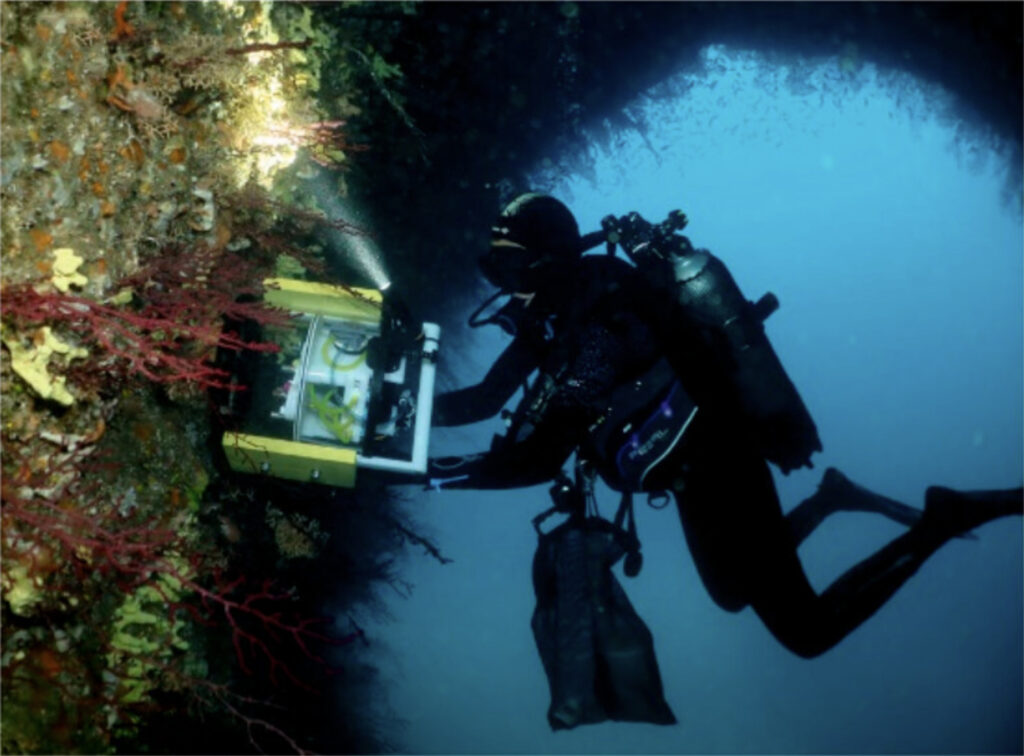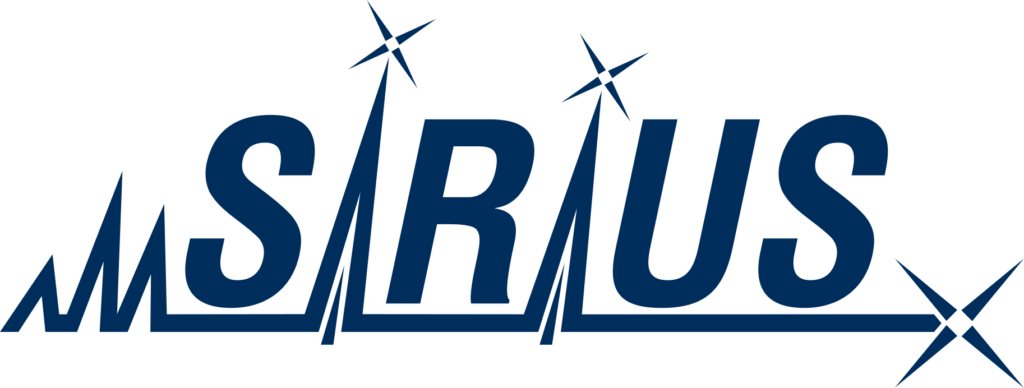What’s in a drop of seawater?
The study of a single drop of seawater reveals an enormous complexity of molecules of different structures and origins, which are often only present in trace amounts and are subject to constantly changing dynamics. To this day, it is a challenge to analyze the chemical composition of seawater in order to understand its influence on the functions of the ecosystem.
Sampling and measurement techniques have steadily improved: there are specialized sensors, better chromatographic resolution and more accurate mass spectrometry detection1,2 of thousands of molecules in high throughput. But the accurate identification of molecules diluted in seawater is still difficult. The reasons are manifold: (1) their low abundance in the collected samples, which precludes purification, (2) their unknown or multiple biosynthetic origins and the possible (bio)transformations they undergo, (3) a lack of available standards or spectra. What is needed is an instrument capable of concentrating dilute metabolites in seawater.
Life at the bottom of the sea
The benthic zone is the ecological region at the lowest level of a body of water. A holobiont is a biological system consisting of a eukaryotic host organism and a number of prokaryotic species living in close association with it. Benthic holobionts, such as sponges, influence the chemical composition of their environment by producing and releasing a plethora of structurally diverse specialized metabolites called exometabolites. Exometabolites contribute to the holobiont’s adaptation within its ecosystem and are implicated in their defense, growth, and communication strategies; for example, they may serve as nutrients and/or be sensed as signals3.
Marine chemical landscapes are constantly changing in time and space3,4. Deciphering the chemical signatures of seawater requires examining and distinguishing the individual metabolic contributions of marine organisms before they are added to the pool of other chemicals and may be metabolized multiple times, forming complex marine chemical landscapes.
Taking a deep dive

What we need is a device that allows us to detect these exometabolites immediately after their release, before extensive biotransformations take place and, most importantly, without harvesting or damaging the producing organisms. About 40 years ago, the first submersible device was developed to detect metabolites in the coral environment5. It only worked in shallow water and with a relatively long sampling time. The research group led by Thierry Pérez at the Institut Méditerranéen de Biodiversité et d’Ecologie marine et continentale in Marseille, France, has therefore developed a new underwater solid phase extraction device, the In Situ Marine moleculE Logger I-SMEL6. The I-SMEL chamber enables the in situ collection and enrichment of molecules from the water and aims to concentrate diluted molecules from large volumes of seawater (>10 L) in a delimited zone within a short time (10-30 min). The device is designed to be easily handled underwater by a single diver and can be used at different depths in different configurations. I-SMEL does not need to lie flat or be held on a flat surface. I-SMEL paves the way to study marine organisms and the compounds they produce in their native environment with minimal disturbance to the organisms and their surrounding environments.
Test in the Mediterranean Sea
The device was used in a Mediterranean ecosystem at a depth of 15 m, which in many ways resembles tropical coral reefs in terms of species richness and functionality. The shaded parts of this ecosystem consist of species communities dominated by sponges that are prolific producers of specialized metabolites7,8. The group studied three common and rather large species whose specialized metabolites are well described in the literature9–13. Using I-SMEL, they sampled the average marine chemical landscape of the target ecosystem, as well as samples directly above the respective sponges to concentrate their specialized exometabolites.
The researchers analysed the samples using untargeted ultra-high-performance liquid chromatography coupled to quadrupole time-of-flight tandem mass spectrometry with positive electrospray ionization. They processed the raw data using MZmine14, resulting in 2248 features, and generated a feature-based molecular network15 on the GNPS16 platform. To enhance molecular formula assignment and understand chemical class distribution within the spectral families in the network, they used SIRIUS17 and CANOPUS18. This approach provided a detailed description of exometabolite structural diversity. Dereplication was performed using spectral data available either from previously identified compounds or in GNPS libraries16. If no reference data was available, the molecules were manually annotated spectra using MetFrag19 and CSI:FingerID20.
Three sponges examined
The researchers compared the exometabolite samples from outside the sponges with crude extracts from inside the respective sponges. They detected the most common specialized metabolites from the crude extracts of S. officinalis and A. cavernicola also in their exometabolite sample. Exometabolites structurally derived from known specialized metabolites were also sporadically detected in each of the three sponge species. Some of the released specialized metabolites may have been slightly (bio)transformed prior to their detection. Overall, only a fraction of the known specialized metabolites characterizing the sponge crude extract were recovered as exometabolites. Some of them may have remained undetected because their presence in trace amounts is below the detection limit. Alternatively, they may be retained by the body mass of the sponge as a possible defense mechanism against predators or competitors21. The researchers found that the diversity and proportion of exometabolites differed greatly not only between species, but also between biological replicates of the same species, suggesting individual variability in exometabolite production.
I-SMEL is addressing the need to capture exometabolites immediately after release, allowing in situ collection and enrichment without causing harm to organisms. In combination with untargeted mass spectrometry data analysed using SIRIUS, CANOPUS and CSI:FingerID it holds promise for studying endangered species in marine protected areas, assessing seasonal variations in exometabolite production, and monitoring toxins or human impacts in the marine environment.
References
- 1.da Costa Filho BM, Duarte AC, Rocha-Santos TAP. Environmental monitoring approaches for the detection of organic contaminants in marine environments: A critical review. Trends in Environmental Analytical Chemistry. Published online March 2022:e00154. doi:10.1016/j.teac.2022.e00154
- 2.Magi E, Di Carro M. Marine environment pollution: The contribution of mass spectrometry to the study of seawater. Mass Spectrometry Reviews. Published online September 9, 2016:492-512. doi:10.1002/mas.21521
- 3.Hay ME. Marine Chemical Ecology: Chemical Signals and Cues Structure Marine Populations, Communities, and Ecosystems. Annu Rev Mar Sci. Published online January 1, 2009:193-212. doi:10.1146/annurev.marine.010908.163708
- 4.Saha M, Berdalet E, Carotenuto Y, et al. Using chemical language to shape future marine health. Frontiers in Ecol & Environ. Published online October 2, 2019:530-537. doi:10.1002/fee.2113
- 5.Coll JC, Bowden BF, Tapiolas DM, Dunlap WC. In situ isolation of allelochemicals released from soft corals (Coelenterata : Octocorallia): A totally submersible sampling apparatus. Journal of Experimental Marine Biology and Ecology. Published online April 1982:293-299. doi:10.1016/0022-0981(82)90166-6
- 6.Mauduit M, Derrien M, Grenier M, et al. In Situ Capture and Real-Time Enrichment of Marine Chemical Diversity. ACS Cent Sci. Published online November 8, 2023:2084-2095. doi:10.1021/acscentsci.3c00661
- 7.Mehbub M, Lei J, Franco C, Zhang W. Marine Sponge Derived Natural Products between 2001 and 2010: Trends and Opportunities for Discovery of Bioactives. Marine Drugs. Published online August 19, 2014:4539-4577. doi:10.3390/md12084539
- 8.Carroll AR, Copp BR, Davis RA, Keyzers RA, Prinsep MR. Marine natural products. Nat Prod Rep. Published online 2022:1122-1171. doi:10.1039/d1np00076d
- 9.Mauduit M, Greff S, Herbette G, et al. Diving into the Molecular Diversity of Aplysina cavernicola’s Exometabolites: Contribution of Bromo-Spiroisoxazoline Alkaloids. ACS Omega. Published online November 16, 2022:43068-43083. doi:10.1021/acsomega.2c05415
- 10.Kovalerchik D, Singh RP, Schlesinger P, et al. Bromopyrrole Alkaloids of the Sponge Agelas oroides Collected Near the Israeli Mediterranean Coastline. J Nat Prod. Published online February 19, 2020:374-384. doi:10.1021/acs.jnatprod.9b00863
- 11.Chen Q, Mao Q, Bao M, et al. Spongian Diterpenes Including One with a Rearranged Skeleton from the Marine Sponge Spongia officinalis. J Nat Prod. Published online May 16, 2019:1714-1718. doi:10.1021/acs.jnatprod.9b00270
- 12.Bauvais C, Bonneau N, Blond A, Pérez T, Bourguet-Kondracki ML, Zirah S. Furanoterpene Diversity and Variability in the Marine Sponge Spongia officinalis, from Untargeted LC–MS/MS Metabolomic Profiling to Furanolactam Derivatives. Metabolites. Published online June 13, 2017:27. doi:10.3390/metabo7020027
- 13.Sauleau P, Moriou C, Al Mourabit A. Metabolomics approach to chemical diversity of the Mediterranean marine sponge Agelas oroides. Natural Product Research. Published online February 6, 2017:1625-1632. doi:10.1080/14786419.2017.1285298
- 14.Schmid R, Heuckeroth S, Korf A, et al. Integrative analysis of multimodal mass spectrometry data in MZmine 3. Nat Biotechnol. Published online March 1, 2023:447-449. doi:10.1038/s41587-023-01690-2
- 15.Nothias LF, Petras D, Schmid R, et al. Feature-based molecular networking in the GNPS analysis environment. Nat Methods. Published online August 24, 2020:905-908. doi:10.1038/s41592-020-0933-6
- 16.Wang M, Carver JJ, Phelan VV, et al. Sharing and community curation of mass spectrometry data with Global Natural Products Social Molecular Networking. Nat Biotechnol. Published online August 2016:828-837. doi:10.1038/nbt.3597
- 17.Dührkop K, Fleischauer M, Ludwig M, et al. SIRIUS 4: a rapid tool for turning tandem mass spectra into metabolite structure information. Nat Methods. Published online March 18, 2019:299-302. doi:10.1038/s41592-019-0344-8
- 18.Dührkop K, Nothias LF, Fleischauer M, et al. Systematic classification of unknown metabolites using high-resolution fragmentation mass spectra. Nat Biotechnol. Published online November 23, 2020:462-471. doi:10.1038/s41587-020-0740-8
- 19.Ruttkies C, Schymanski EL, Wolf S, Hollender J, Neumann S. MetFrag relaunched: incorporating strategies beyond in silico fragmentation. J Cheminform. Published online January 29, 2016. doi:10.1186/s13321-016-0115-9
- 20.Dührkop K, Shen H, Meusel M, Rousu J, Böcker S. Searching molecular structure databases with tandem mass spectra using CSI:FingerID. Proc Natl Acad Sci USA. Published online September 21, 2015:12580-12585. doi:10.1073/pnas.1509788112
- 21.Puglisi MP, Sneed JM, Ritson-Williams R, Young R. Marine chemical ecology in benthic environments. Nat Prod Rep. Published online 2019:410-429. doi:10.1039/c8np00061a





